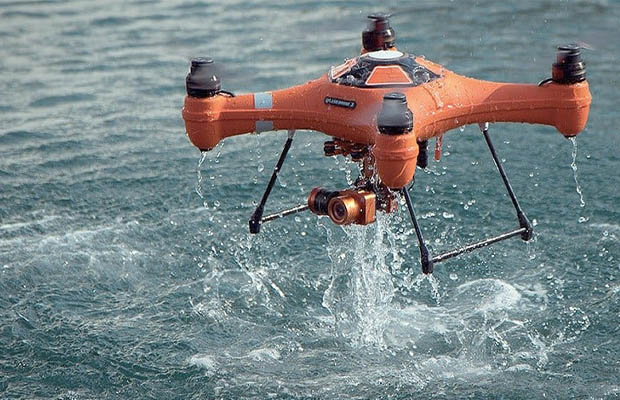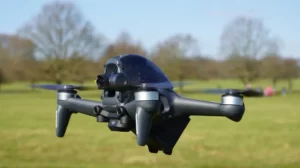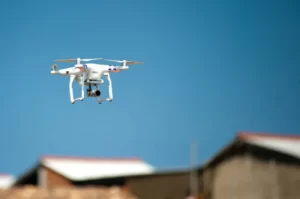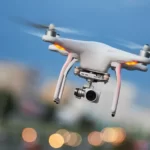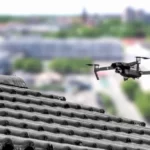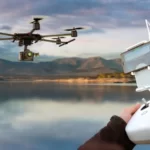I don’t know a lot about fishing, but I do know a lot about drones. Fishing with a drone is simply using a drone to cast and bring fish to the shores. You can find all the information you require here.
One way to use a drone for fishing is to scout from the air to locate fish in the water below. Another more direct way is to use the drone to drop a bait line in the water, either from the shoreline or from a boat, getting the bait and hook much farther than you can by casting it.
Let’s dissect it to see if drone fishing is a viable but efficient method of surveying the water.
Table of Contents
Can You Use a Drone for Fishing, and How Does It Work?
A drone can be used to fish, yes. A drone with a large payload capacity and a bait-release mechanism are all that are required.
It’s similar to casting with traditional fishing rods, with the exception that you can do it from the shore without launching a boat into the water.
Using a Drone for Surf Fishing
Another popular and helpful way to use a drone for fishing is by rigging the drone with a bait line that it can carry out and drop as far as half a mile out from the beach, much farther than you could ever cast with a reel.
The bigger and better predator fish typically stay out a little further, past the first set of breakers, while smaller bait fish frequently come in closer to shore. Sport fishermen trying to land a large fish from shore have historically found this area to be tantalizingly close to being out of reach. But here’s where drones really upend the status quo.
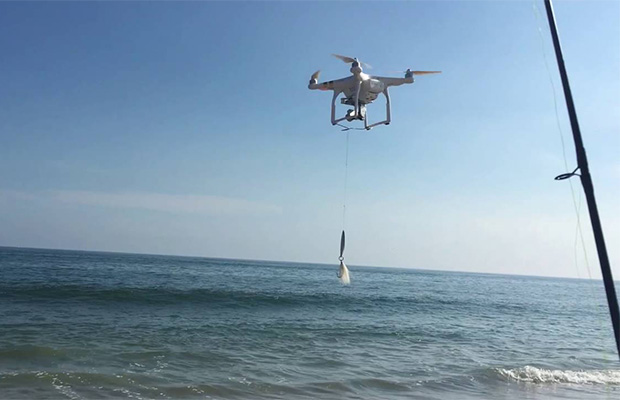
The length of your fishing line and the drone’s controller range are your only real constraints when it comes to how far a drone can be configured to carry a baited line out past the breakers. Specialized drone fishing rigs will release the line, and presto, your bait is dropped right where you want it to be, out where the big fish are.
Moreover, it is not required to be a blind drop. You can even spot a fish using your 4K camera to look down from above, drop the bait there, and increase your chances of hooking the big one. Even if you don’t see any fish while flying to deeper waters, you can still use the camera to locate underwater features like sandbars and make a more strategic drop.
Read More: How To Use Drones In Construction?
Using a Drone to Fish from a Boat
Drone boat fishing involves some scouting and some bait dropping, as previously mentioned. Using your drone, you can scout out the locations of fish, including the ones you’re trying to catch and the schools of baitfish they’re probably hunting. The drone’s special aerial vantage point can be used to learn about the underwater features close to where you are.
The drone can be used to drop baited lines from your boat, much like you might do with a kite or a balloon. A drone has the same ability to deliver the bait to the fish without scaring them off with the sound of boat motors, with the added benefit of not relying on the wind, as these fishing techniques. It is capable of following your instructions. Furthermore, you can use the drone camera feed to see where you’re placing your bait and choose where and when to drop it based on what you see.
Just remember if you’re flying a drone from the deck of your boat to disengage the return to home function, or set it to return to the controller and not the take-off point, to avoid having your drone “land” itself in the middle of the water. To get a feel for flying with a baited line while not over water, practice catching your drone in midair rather than attempting to land it on the boat’s deck.
Tips on How to Use a Drone to Scout for Fish
- Utilize the drone to learn more about the topography of the area where you are fishing. Make a note of important details.
- Scout the surrounding areas, such as the shoreline, weed lines, color-change lines, underwater rock formations or sandbars, etc.
- Learn about the patterns and behavior of fish with the aid of the drone. Keep track of the areas where they frequently appear.
- Set the drone up for initial reconnaissance or to adjust the drone’s position. You shouldn’t depend on it to find every fish you want to catch.
- To have the flight time you require on any given fishing trip, have at least one spare battery or, better yet, two.
- To prevent frightening fish with vibrations from the propeller wash on the water surface, fly the drone at least 30 feet above the water.
- Make sure to either disable Return to Home or set the drone to return to the controller rather than the takeoff point if you’re scouting from a moving boat.
- Instead of attempting to land on a boat deck or a sandy beach, practice catching the drone mid-air when bringing it down to land.
Is It Legal to Fish With a Drone?
The International Game Fish Association, which was established in 1940, sets the guidelines for moral fishing. The rules established by the association are only one level of legality to be aware of, with different regulations for saltwater, freshwater, and fly fishing. Every state in the United States, as well as every nation on earth, is free to enact its own fishing regulations.
Outriggers, downriggers, kites, and other gear are prohibited, according to the International Game Fish Association. may be used to trail baited lines, provided the line releases from the device the moment a fish bites. The International Game Fish Association has approved the use of drones for fishing as long as the line releases either before or after a fish strikes the bait. The act of retrieving a fish that has been hooked with a line attached to a drone is prohibited.
In that case, your state or country’s laws, or perhaps local ordinances, will determine whether using a drone to fish is legal. For instance, according to the International Game Fish Association, drone fishing is permitted in Florida. A Miami local ordinance, however, forbids drones from transporting any weaponry or detachable cargo. This law may be broken by a drone that is carrying a detachable fishing line. In Orlando, drones are prohibited from flying within 500 feet of any gathering of a thousand or more people as well as any city parks. If you’re going to be using a drone to fish, you might need to be careful about where you choose to go.
Another illustration is the fact that drone use is prohibited in Texas when it comes to sport or recreational hunting, which includes fishing. This includes using a drone to drop baited lines and to locate or scout for fish. So if you were hoping to pick up drone fishing and happen to be in I apologize, but Texas is off limits. Be sure to research the state laws and local ordinances where you intend to fish to ensure that using a drone for fishing is permitted there before you go out and buy one.
Is It Ethical to Fish With a Drone?
Fishing with a drone is ethical as long as it releases the line when a fish bites, according to the International Game Fish Association, which is primarily concerned with ethical fishing methods. Others, however, are not persuaded. Some people claim that using a drone to find the fish and then deliver the bait to the exact location where the fish are cheating too much. The excitement of the pursuit and the difficulty of finding the fish are what draw people to sport fishing. Is it still a challenge and a chase if a drone makes finding the fish so simple?
The issue of conservation is also present. Does the ease with which drones enable both experienced and novice fishermen to capture highly sought-after predator fish or endangered species increase the risk of overfishing these marine populations?
At least in most places, it is still a matter of personal preference whether or not you decide to go drone fishing yourself or prefer to catch your fish using more conventional techniques. The advantages and potential drawbacks of any new technology must be weighed, and unintended consequences frequently come to light much later. The use of drones for fishing is currently considered to be morally acceptable, though some purists believe that it goes too far in favor of the fishermen and deprives the fish of a chance to compete in sport.
Drone Fishing Rules and Regulations
I consider drone fishing to be a bit of a loophole because I am an angler myself and I respect the sport of fishing. People are always looking to take advantage of any gaps in the system.
Generally speaking, fishing hasn’t changed much since the prehistoric times when it was done with a stick and a woven net. Fishing is a primitive activity by nature.
There is a chance for abuse and exploitation of the fishing population when using a drone.
Therefore, to protect the fish population, it is the duty of local departments of natural resources and fishing organizations to control how people are catching fish with drones.
Federal regulations for “recreational” drone use states that it must be:
- Registered and clearly marked with the registration number
- Flown for recreational purposes only (you cannot fish commercially with a drone)
- Flown at or below 400 feet
- Within the operator’s visual line of sight at all times
- Not flown at night without proper lighting
These are the only federal laws that pertain to fishing; there are others. Click the link I provided above to view the entire list.
It’s important to remember that your state may have specific drone fishing laws.
Authorities in Florida, for instance, found drone fishermen casting their lines into a school of tuna from the shore.
The distance between the line and the surf and the area where they could normally cast it were both clearly out of bounds.
This raises some ethical issues. While many fishing organizations and anglers were dissatisfied, the authorities were unable to come up with a solid justification for banning drone use.
Only if the operator is breaking any local drone or fishing laws would there be any legal issues.
Therefore, it is still your responsibility to comprehend all drone-related laws in that particular local municipality, including those governing catch and release, proper fish handling, bag limits, and drone use.
It’s beginning to sound like a lot of work, don’t you think?
All of these laws and rules are in place to stop abuse and promote recreational angling as opposed to exploitation for financial gain.
How Much Does a Fishing Drone Cost?
In the event that the pilot makes a mistake, fishing drones are built to prevent collisions with the water.
Make sure you purchase a high-quality fishing drone, preferably one that costs $500 or more, as fishing drones that fall below this price point do not have sufficient lifting power or a long battery life. Their GPS capabilities are also quite limited.
A good fishing drone costs between $500 and $1500. You must look for a device with a large lifting capacity, excellent battery life, and cutting-edge GPS capabilities.
If you want to fly your drone near water, some of them are also waterproof. But the waterproof drones will cost you more.
The 30-minute battery life of the typical drone is sufficient for you to launch it, cast your bait, land a fish, and then retrieve the drone.
Consider purchasing a set of extra batteries to supplement the drone’s battery if your fishing goals are longer-term. Batteries for drones can range in price from $60 to $140.
Final Thoughts on Fishing With a Drone
It may seem simple, but it’s not really that easy. In some places, flying drones is prohibited, and there are a lot of potential obstacles. Without a boat or with one, drones will let you cast up to 500 meters into the ocean.
Within the next two decades, fishing will experience a number of advancements, including drone fishing. You can tell from my position on the matter that there are risks and the potential for abuse, though.
You May Also Like:
FAQs
How Many Hooks Do You Need for Drone Fishing?
Two ten hook long-line backbone sections for clipping the traces to. Be aware of the rules; a longline defined as having more than 7 hooks on a line requires a buoy bearing your name and address.
What Length Rod for Drone Fishing?
The ultimate drone fishing rod, 12 foot to get you over the surf, 3 piece for easy travel, and a heavy action for the stiffness required to keep your line tight.
